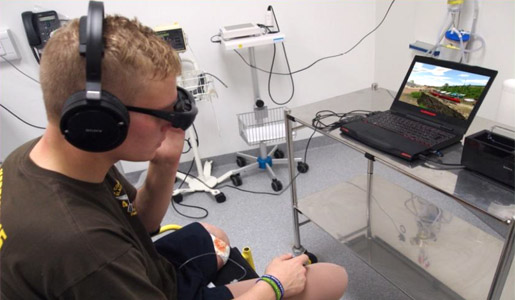 Previous research suggests that exposure of individuals to natural settings can promote stress reduction and assist in the recovery of attentional capacity and cognitive function following mental fatigue.
Previous research suggests that exposure of individuals to natural settings can promote stress reduction and assist in the recovery of attentional capacity and cognitive function following mental fatigue.
Restorative environments as simple as window views onto garden scenes can reduce post-operative recovery periods and analgesic administration. Studies conducted by the Japanese Forestry Institute demonstrated that 15- to 20-minute exposures to natural environments were accompanied by enhanced subjective feelings of "calm" and "refreshed", together with a significant lowering of blood pressure, pulse rate and cortisol levels when compared to similar exposures in a busy city.
Research also suggests that a reduction of symptoms related to prolonged stress and depression, including those brought about by prolonged adverse weather and annual time changes (e.g. Seasonal Affective Disorder), can occur as a result of exposure to green spaces and rural outdoor settings.

- McCloy, R.F., & Stone, R.J. (2001). “Science, Medicine, and the Future: Virtual Reality in Surgery and Medicine”; British Medical Journal; 323; October; pp.912-915.McCloy, R.F., & Stone, R.J. (2004). “Innovation in Surgical Technologies: The Human Factor”; Association of Surgeons of Great Britain & Ireland (ASGBI) Executive Newsletter; 6; Spring; pp.43-44.
- Stone, R.J., & McCloy, R.F. (2004). “Ergonomics in Medicine and Surgery” (with McCloy, R.); British Medical Journal; 328 (7448); 08 May; pp.1115-1118.Stone, R.J. (2005). “Game On for Future Battlefield Surgeons”; Equipment, Training & Support News; Autumn.
- Stone, R.J., & Barker, P. (2006). “Serious Gaming: A New Generation of Virtual Simulation Technologies for Defence Medicine & Surgery”; International Review of the Armed Forces Medical Services; 79(2); June; pp.120-128.
- Stone, R.J. (2011). “The (Human) Science of Medical Virtual Learning Environments”; Invited Paper; Philosophical Transactions of the Royal Society B; 366 (1562); pp.276-285.Depledge, M., Stone, R.J., & Bird, W. (2010). “Can Natural and Virtual Environments be Used to Promote Improved Human Health and Wellbeing?”; Environmental Science and Technology; 45(11); June; pp.4659-5064.
- Stone, R.J. (2012). “Virtual Reality for Post-Operative Restoration and Rehabilitation”; Clinical Front Line; Royal Centre for Defence Medicine; March.Knight, J.F.,
- Stone, R.J., & Qian, C. (2012). “Virtual Restorative Environments: Preliminary Studies in Scene, Sound and Smell”; International Journal of Gaming and Computer-Mediated Simulations (IJGCMS); 4(3) – Ludica Medica Special Issue; July-September; pp. 73-91.
- Stone, R.J., Small. C., Knight, J.F., Qian, C., & Shingari, V. (2014). “Virtual Environments for Healthcare Restoration and Rehabilitation”; Part VI in Ma, M., Jain, L.C., & Anderson, P. (Eds.), “Virtual and Augmented Reality in Healthcare 1”; Intelligent Systems Reference Library Volume 68; 2014; Springer-Verlag: Heidelberg, Germany; pp. 497-521.